
“Quite simply, the absolute best”: Tributes to Art Lien
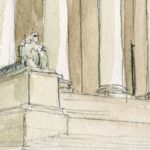 By SCOTUSblog
By SCOTUSblog on Sep 30, 2022 at 4:35 pm
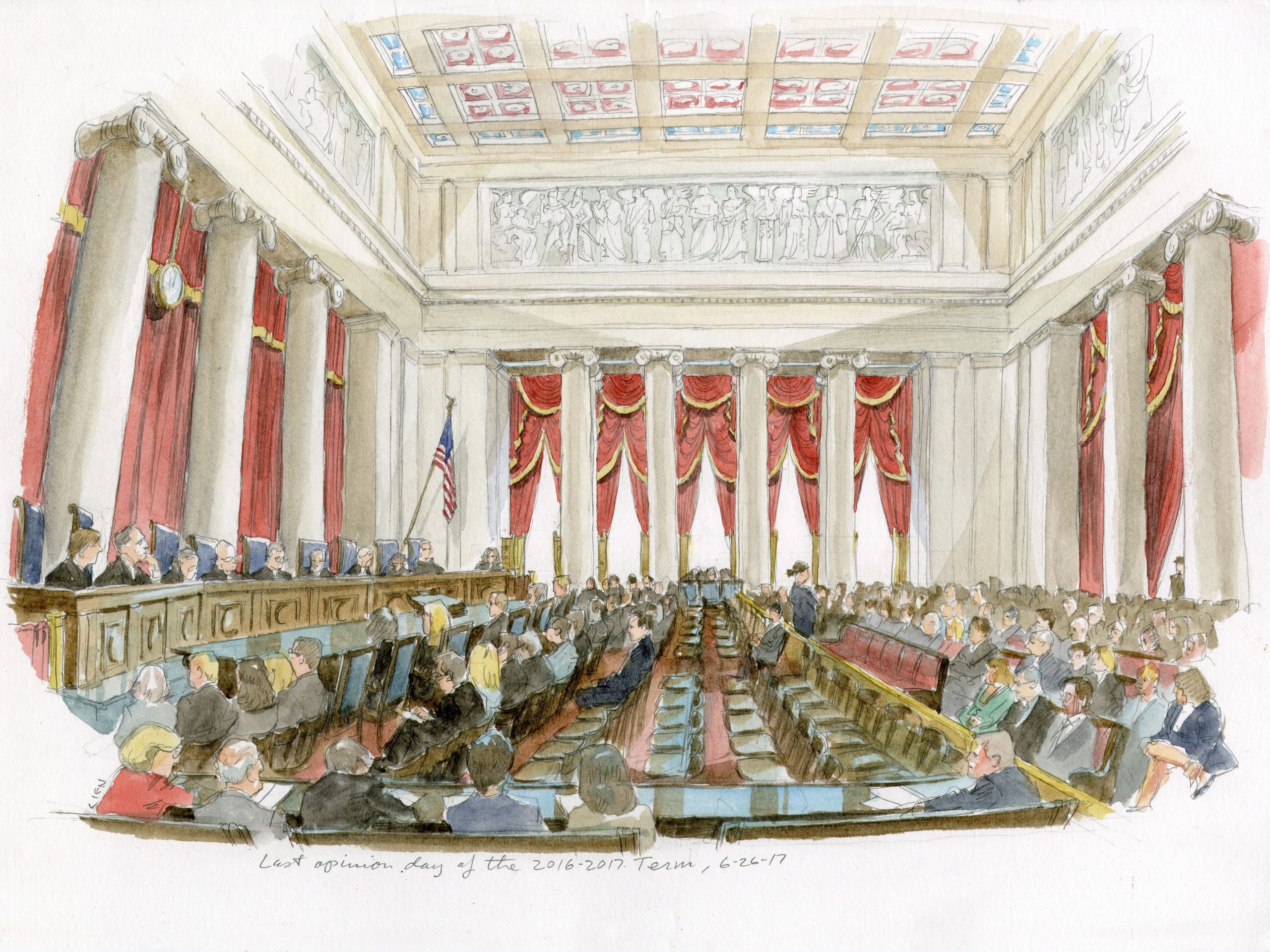 The Supreme Court announces its last opinion of the 2016-17 term. (Art Lien) Share
The Supreme Court announces its last opinion of the 2016-17 term. (Art Lien) ShareArt Lien sketched the Supreme Court from 1977 until his retirement this summer. For the final nine years of that astounding career, he worked for SCOTUSblog (in addition to his longtime employer, NBC News.) Over 45 years, Art visually chronicled dozens of justices, thousands of cases, and innumerable moment-by-moment developments at the court and in the law. We asked journalists, Supreme Court practitioners, and other experts who know and love his work to weigh in on what makes Art so special.
Amy Howe and Tom Goldstein Founders of SCOTUSblogThe Supreme Court is a notoriously opaque institution. There are no cameras or videos allowed, and – until the pandemic – audio recordings of oral arguments were normally not available for several days. For the past nine years, Art has provided SCOTUSblog readers with a rare window into the Supreme Court’s operations.
The bread and butter of Art’s work has focused on capturing the oral arguments themselves. He has covered some of the most significant arguments of our generation, including Dobbs v. Jackson Women’s Health Organization and New York Rifle & Pistol Association v. Bruen just this past term. In those cases and hundreds of others, Art depicted the advocates, the justices on the bench, and the majesty of the courtroom itself. True to his name, Art’s courtroom sketches are genuine art, as he consistently managed to convey a sense of mood and action far beyond what viewers would expect from a “still life.”
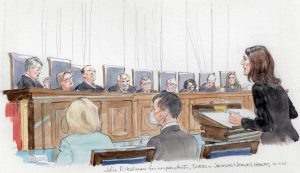
Julie Rikelman argues on behalf of an abortion clinic in Dobbs v. Jackson Women’s Health Organization.
When the justices pivoted to holding oral argument by telephone because of the COVID-19 pandemic, Art was ready. Art asked the arguing lawyers to send him pictures of their oral argument set-ups, and the vast majority of them agreed. The series of sketches that followed was in a sense a metaphor for the pandemic itself. Instead of standing at a lectern before the justices, dozens of lawyers argued alone (or, sometimes joined by students wearing masks), but with very different approaches: Some dressed formally and stood at their own lectern, while others wore hoodies and sat at a table. And at least one lawyer, we saw, argued from her home office, with her cat perched on a nearby shelf.
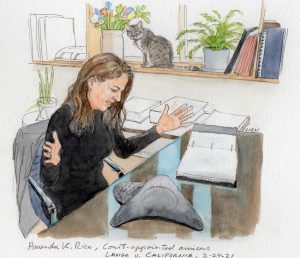
Amanda Rice argues remotely in Lange v. California in February 2021.
Art’s work was not, however, limited to oral arguments. He chronicled the court’s remembrances of Justice Antonin Scalia after Scalia’s death in 2016, the ceremonies to formally welcome new justices, and the presence of celebrities in the courtroom (or least people who pass for celebrities in Washington).
Even the most casual readers of SCOTUSblog are familiar with Art’s banners – the sketches that grace the top of the site every day. Although the banners may have been originally intended as a simple way to add some visual interest to a homepage packed with text, they quickly became so much more than that, often keeping readers up to date on the weather and events outside the court, depicting everything from Washington’s famous cherry blossoms and police officers standing in the rain to the barricades that surrounded the court after the Jan. 6, 2021, insurrection and the abortion protests in 2022.

A security fence surrounds the Supreme Court after the attack on the Capitol.
Other banners took a more whimsical approach, showing the justices in various costumes. Sometimes Art’s inspiration for the banners came from the cases being argued before the court. When the justices heard oral argument in Yates v. United States – a fisherman’s challenge to his conviction for violating a federal law prohibiting the destruction of evidence, which in his case was fish that were smaller than the legal limit – Art sketched each of the justices as a fisherman, dressed in foul-weather gear and displaying their catches (or, for Justice Stephen Breyer, the lack thereof). And when Washington’s hometown hockey team won the Stanley Cup, Art commemorated the occasion with a banner showing the justices dressed as hockey players, with Chief Justice John Roberts hoisting the cup above his head.

The justices as fishermen.

The justices on ice.
Although we will miss Art’s sketches, we will miss him even more as a colleague. As Art notes on his own blog, being a courtroom sketch artist is demanding and stressful, requiring work on a tight deadline. But despite these demands, Art never let us see him sweat. He was a consistently warm, cheerful, and unassuming presence in the court’s press room and in the seats set aside for journalists. We wish him a very restful retirement, with weekday mornings now filled with bike rides and leisurely cups of coffee with his wife rather than traffic-heavy car commutes to 1 First Street, and we thank him for sharing his considerable talents with the rest of us.
Clare Cushman Resident historian, Supreme Court Historical SocietyArt’s daily sketches of events at the court have been a lively and useful record for reporters and for oral advocates who cherish having their appearances vividly rendered. For historians, they are an extraordinarily precious resource. That is because Art is able to fully capture both the look and feeling of being inside the courtroom or on the building’s premises at a precise moment in time. In 50 years, when a historian is writing about a court decision, pouring over the dry words in U.S. Reports, Art’s sketch will help her imagine the scene — the justices on the bench, the spectators, the press, the court staff, the weather, the emotion — of what took place on the day it was argued or handed down.
He also is keenly aware of the subtle nuances of changes to procedures and customs at the Marble Palace and captures small, telling details with his brush. Often with a wink of humor or a sigh of emotion. When I asked him to draw a fanciful scene of the justices having lunch for my book Table for 9, to show their efforts at cordiality around breaking bread together, he outdid himself. In addition to perfect renderings of the justices enjoying a Thanksgiving meal, he added Justice Neil Gorsuch (who was at the time the junior justice) opening the door for the chef to bring in the turkey. And he drew a portrait of John Marshall over the mantelpiece and a bottle of Madeira to give a nod to the boarding-house traditions established by that chief justice. Delightful.
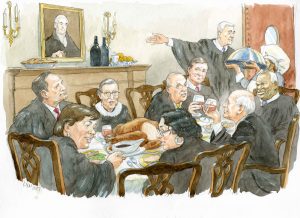
The justices on Thanksgiving.
Future court watchers will be grateful for his keen eye and profound observations — all made with a smidge of pigment and H2O.
Nina Totenberg NPR legal affairs correspondentFor decades I have watched Art Lien in the courtroom. Not just the Supreme Court chamber. In many ways, the dozens of trials that he and I have covered have been the most challenging for an artist, because in trials the main characters are not just nine justices who reappear time and again. In trials, there is an ever-changing cast of characters — from the defendants and their families, to the witnesses, the prosecutors, and defense lawyers, and the judge. Art has mastered all of these challenges while at the same time being a wonderful, calm, funny, and dear colleague. We will all miss him very much.
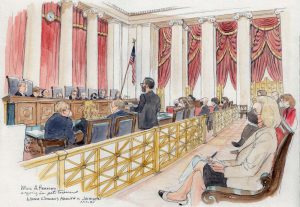
Oral argument in Whole Woman’s Health v. Jackson in November 2021. Totenberg sits in the foreground.
Kannon Shanmugam Chair of Supreme Court and appellate practice group, Paul WeissIt’s hard to imagine being in the Supreme Court without seeing Art and his sketch pad. Over the years, Art has captured all of the big moments of my career and those of so many others – including in his famous sketches of the telephonic arguments during the pandemic. I have one of Art’s sketches in my office, and visitors frequently remark upon how perfectly he captures the justices and lawyers. At the risk of going all Carly Simon here, nobody does it better. And he is a wonderful and interesting person to boot. He will be very much missed.
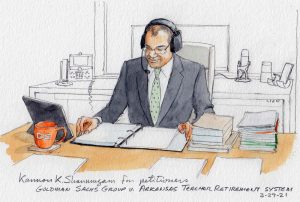
Shanmugam argues remotely in March 2021.
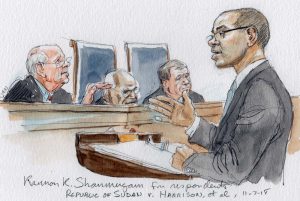
Shanmugam argues in person in November 2018.
Steven Mazie Supreme Court correspondent at the Economistperceptive, gentle
brilliant, kind and full of wit
we will miss you Art!

Supreme Court journalists in the press room on an opinion day.
Joan Biskupic CNN legal analystOn the wall of my office, in prized space above my desk, I’ve hung a framed, signed copy of Art Lien’s brilliant “Pandemic Teleconference.” Every detail is perfect: the chief at the old-fashioned switchboard; RBG lifting a weight in one hand, the phone in the other; Alito on shoe phone; Thomas with a copy of the US Reports; Kagan twirling the cord of a pink princess phone. Art’s creative talent, canny observation and whimsy come through in all nine panels. I’m never taking the piece down, and I will remember Art Lien. All the best in retirement, Art.

The Supreme Court’s “pandemic teleconference.”
Mark Walsh Supreme Court correspondent at Education Week and SCOTUSblog contributorArt Lien sketched Supreme Court arguments for some 45 years before retiring. At some point, maybe 15 years ago, I often ended up assigned to the third row of the press section, seated next to Art or one of the two or three other credentialed sketch artists who depict what goes on in the courtroom.
That row is the natural spot where the court puts the artists. It is behind the two rows of cushioned benches where the most senior correspondents sit during arguments. And those three rows have small desktops that run the length of the press section.
The desktop gives the artists room to spread out their sketchpads, pencils, and other tools. Some of Art’s colleagues use very large sketchbooks, and I spent many an argument with the corner of such a book digging into my side. Art uses a more modestly sized sketchbook.
I struck up a friendship with Art as we typically arrived in the courtroom 20 or 30 minutes before the justices took the bench. We would look for any dignitaries and luminaries – spouses of the justices across the bar section in the VIP box, well known lawyers in the bar section, and the occasional figure from the world of entertainment. Lawrence Fishburne came to an argument one day when he was appearing onstage in Washington in a play about as the late Justice Thurgood Marshall. Broadway star Lin-Manuel Miranda and actress and LGBTQ activist Laverne Cox attended arguments in recent years. Art always had his trusty monocular available to get a closer look.
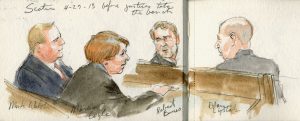
From left: Mark Walsh of Education Week, Marcia Coyle of The National Law Journal, Robert Barnes of The Washington Post, and Adam Liptak of The New York Times.
When I would get a seat in one of the first two rows of the press section, I quickly learned that I risked a cameo appearance in one of his sketches. Art would often draw the sides or backs of the heads of the correspondents who were in his line of sight as he captured the lawyers arguing cases or the justices asking questions. I learned to try to take a seat a little to his right, just out of his sightline to the bench, but still close enough to chat with him before arguments.
Art has long contended that he did not pay close attention to the briefs and arguments in most of the cases he sketched. But when an argument ended, he would invariably have a good sense of which side was likely to win.
Art became well known for his SCOTUSblog banners, the sometimes fanciful drawings of the justices with one theme or another. These included his 2015 depiction of the justices as baseball players (with Chief Justice John Roberts as an umpire, course).

The justices play ball.
In recent years, I was honored that Art asked me to help him conceptualize some of those banners, such as when the Washington Capitals won the Stanley Cup. Art depicted the justices in full hockey gear, with Roberts hoisting the cup. (I had suggested that Justice Ruth Bader Ginsburg be outfitted in full goalie gear, but Art told me he was too far along with his sketch by that time.) When the Washington Nationals won the World Series in 2019, Art did agree with me that Ginsburg should be shown in a “Baby Shark” costume that some Nationals fans had taken to wearing during the series.

The justices celebrate the World Series.
My favorite banner came in the spring of 2020 as the pandemic forced the closure of the courtroom, eventually leading to the year-and-a-half experiment with conducting arguments over the telephone. We hit on the idea of giving each justice a different type of phone from which they would be dialing in to the arguments. Some of our choices were maybe a bit on the nose. For Ginsburg, it was an old black desk phone. For Justice Stephen Breyer, it was an even older candlestick phone.
For Justice Clarence Thomas, who rarely participated in oral arguments on the bench, we thought that all he needed was a speakerphone to listen to the arguments, like the one on “Charlie’s Angels.” (Some younger people, unfamiliar with the 1970s TV show or with telephone technology of that era, thought Thomas was listening to a radio.)
When the court actually began hearing the telephone arguments, Thomas surprised many people by suddenly feeling more comfortable about asking questions of every lawyer.
Justice Samuel Alito got the old shoe phone used by Maxwell Smart in the 1960s TV series “Get Smart.” We figured that Alito was the justice most likely to have been a government Kontrol agent in that era. The other justices were depicted with one phone or another, with a harried Roberts shown trying to keep everyone connected at an old-school switchboard.
On April 27, 2022, on the last day of arguments of October Term 2021, two people had their last official days in the courtroom. Breyer had earlier announced his intent to retire at the end of the term, and with the court not planning any opinion announcements from the bench (for the third spring in a row due to the pandemic), the chief justice that day made his poignant and emotional comments about Breyer and his 28 years of “questions challenging and insightful” and “hypotheticals downright silly.”
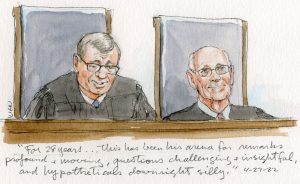
Roberts pays tribute to Breyer.
Of course, Art opened his sketchbook and captured the moment. Then, without fanfare, he packed up his monocular, his pencils, and his sketchbook, and filed out of the courtroom for the last time as a working sketch artist.
Elizabeth Williams Author of The Illustrated Courtroom: 50 Years of Court ArtCourtroom art is a challenge. Tight deadlines weigh on an artist, pushing the limits of skill. It’s like walking a tightrope with no net. The better the drawing skill, the better and more informative the final illustration. Over the last 45 years, with remarkable speed and skill, Lien captured the scene. A great draughtsman, his style and technique evolved over his career. From colored pencils to watercolor, his artwork portrayed to millions historic cases where no camera could go. While many artists rely on chalk and pastel, he developed a unique watercolor technique that was unparalleled. His work was synonymous with the United States Supreme Court, providing images to the eponymous SCOTUSblog and NBC News. His talent, his work, his skill will be missed.
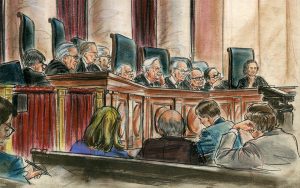
One of Art’s early works: The Burger court in 1986.
Pete Williams Former NBC News Supreme Court correspondentNBC News was fortunate to have Arthur on its team for more than three decades, and I was deeply grateful to work with him covering the Supreme Court and some of that era’s most important trials. He deftly recorded the look of the courtrooms where those events unfolded, but he also had an eye for capturing the most telling and dramatic moments. As an added bonus, he worked surprisingly quickly, turning out several different sketches for a single court hearing, giving us essential flexibility in telling the story. He was an expert in a demanding and highly specialized art form, and he was liked and respected by his peers and the lawyers and judges he covered. He was, quite simply, the absolute best.

One of Art’s final sketches: Demonstrators outside the court after the Dobbs decision in June 2022.
Posted in Retirement of Art Lien, Featured
Recommended Citation: SCOTUSblog , “Quite simply, the absolute best”: Tributes to Art Lien, SCOTUSblog (Sep. 30, 2022, 4:35 PM), https://www.scotusblog.com/2022/09/quite-simply-the-absolute-best-tributes-to-art-lien/
Introducing Jobbguru: Your Gateway to Career Success
The ultimate job platform is designed to connect job seekers with their dream career opportunities. Whether you're a recent graduate, a seasoned professional, or someone seeking a career change, Jobbguru provides you with the tools and resources to navigate the job market with ease.
Take the next step in your career with Jobbguru:
Don't let the perfect job opportunity pass you by. Join Jobbguru today and unlock a world of career possibilities. Start your journey towards professional success and discover your dream job with Jobbguru.
Originally posted on: https://www.scotusblog.com/2022/09/quite-simply-the-absolute-best-tributes-to-art-lien/